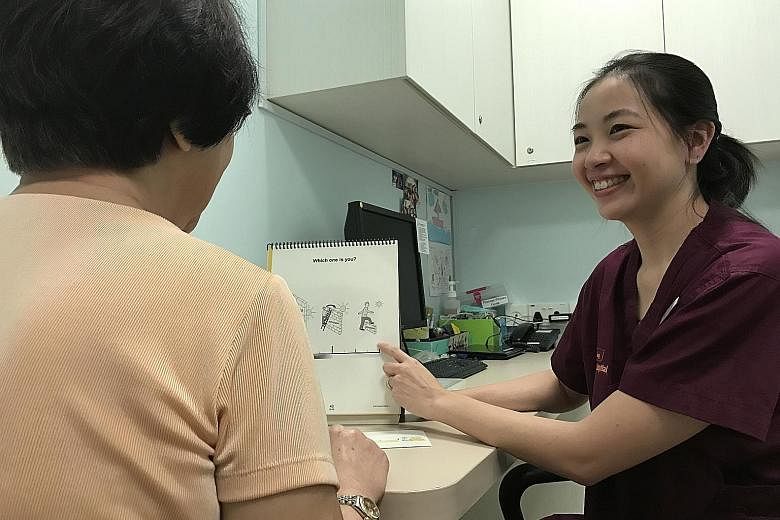A pictorial toolkit introduced here in April has allowed patients who have trouble understanding and producing speech to better express themselves.
Dr Emily Guo, a senior speech therapist at National University Hospital (NUH), said the self-assessment guide has helped to better assess the quality of life of patients with aphasia. The condition, usually a consequence of a stroke, causes the person to struggle with speaking, reading and writing.
Previously, it was difficult to determine how these people felt or to figure out which aspect of communication they need most help with, be it speaking, reading or writing.
"People with aphasia are unable to express themselves not only because they cannot vocalise what they are thinking," Dr Guo said, speaking ahead of NUH's speech therapy day last Thursday. "Some cannot understand the words that they hear. We did not have an accurate way to truly assess the quality of life of people with aphasia."
The self-assessment guide, called the Assessment for Living with Aphasia, overcomes this by asking them to gauge their quality of life through pictures.
It has 45 questions, such as "how do you feel" and "how do you rate your ability to communicate", with one or more pictures illustrating the question and potential responses. For example, the question "how do you feel" has four pictures depicting a person who is lonely, depressed, frustrated and angry. The patient is asked to rate each on how much it illustrates their situation or feelings by pointing to a scale.
Questions also cover topics such as whether the patient is living in an environment conducive for recovery and whether he or she feels respected.
NUH is the first to introduce the toolkit, which was developed in Canada in 2010, in its clinics.
Dr Guo and other researchers had conducted a study of 66 aphasia patients between 2013 and 2015 to determine its suitability for Singaporeans. Participants said the questions with pictures were easy to follow, and that the toolkit covered the main effects that aphasia and strokes had on their lives.
NUH has also developed a Chinese version for Mandarin-speaking patients.
In 2014 alone, 7,846 people were admitted to hospital with strokes in Singapore. Typically a third of sufferers develop aphasia. NUH saw an average of 720 stroke patients each year from 2010 to last year.
Madam Lim Gek Lee, 68, whose husband suffers from aphasia due to a stroke, said pictures are useful when communicating with him.
"It can get quite frustrating for my husband because he has trouble speaking so it's easier if he can point to pictures and rate them," said the retiree in Mandarin.
Separately, Dr Guo and researchers from Singapore and Australia also studied the use of a tablet application to assess how severe a person's aphasia was. A study of 30 patients found that the results were as accurate as those from face-to-face assessments.
Though clinical trials will be needed to assess the effectiveness of treating patients remotely, Associate Professor Gerald Koh from the Saw Swee Hock School of Public Health at the National University of Singapore, one of the paper's authors, said delivering care in such a manner could be a feasible way to provide speech therapy.
Aphasia patients usually suffered a stroke, which means it is challenging for them to travel to outpatient clinics, said Prof Koh. He added that there is also a shortage of speech therapists.
"(Such remote means) may be more convenient for patients and may potentially increase the efficiency of therapists," he said.

